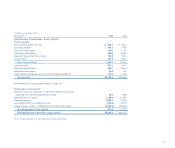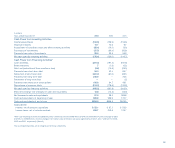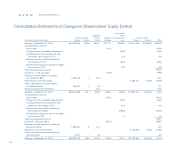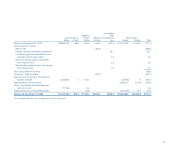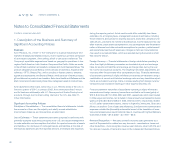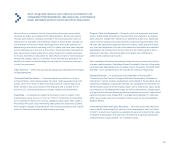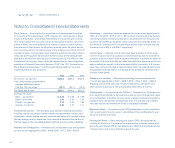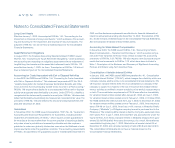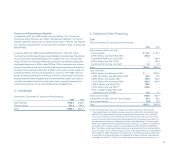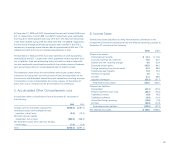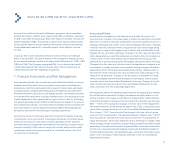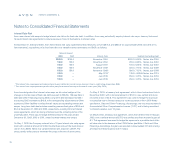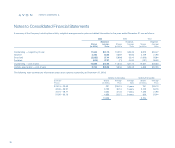Avon 2003 Annual Report Download - page 47
Download and view the complete annual report
Please find page 47 of the 2003 Avon annual report below. You can navigate through the pages in the report by either clicking on the pages listed below, or by using the keyword search tool below to find specific information within the annual report.
Long-Lived Assets
Effective January 1, 2002, Avon adopted FAS No. 144, “Accounting for the
Impairment or Disposal of Long-Lived Assets,” which addresses the account-
ing and reporting for the impairment and disposal of long-lived assets. The
adoption of FAS No. 144 did not have a material impact on the Consolidated
Financial Statements.
Asset Retirement Obligations
In August 2001, the Financial Accounting Standards Board (“FASB”) issued
FAS No. 143, “Accounting for Asset Retirement Obligations,” which addresses
the accounting and reporting for obligations associated with the retirement of
tangible long-lived assets and the associated retirement costs. FAS No. 143
was effective January 1, 2003, for Avon. The adoption of FAS No. 143 did not
have a material impact on the Consolidated Financial Statements.
Accounting for Costs Associated with Exit or Disposal Activities
In June 2002, the FASB issued FAS No. 146, “Accounting for Costs Associated
with Exit or Disposal Activities.” This statement supersedes EITF No. 94-3,
“Liability Recognition for Certain Employee Termination Benefits and Other
Costs to Exit an Activity (Including Certain Costs Incurred in a Restructuring).”
FAS No. 146 requires that a liability for a cost associated with an exit or disposal
activity be recognized when the liability is incurred. Under EITF 94-3, a liability is
recognized at the date an entity commits to an exit plan. FAS No. 146 also estab-
lishes that the liability should initially be measured and recorded at fair value. The
provisions of FAS No. 146 were effective for any exit and disposal activities initi-
ated after December 31, 2002.
Guarantees
In November 2002, the FASB issued Interpretation (“FIN”) No. 45, “Guarantor’s
Accounting and Disclosure Requirements for Guarantees, Including Indirect
Guarantees of Indebtedness of Others,” which requires certain guarantees to
be recorded at fair value rather than the current practice of recording a liability
only when a loss is probable and reasonably estimable and also requires a
guarantor to make new guaranty disclosures, even when the likelihood of mak-
ing any payments under the guarantee is remote. The accounting requirements
of FIN No. 45 was effective for guarantees issued or modified after December 31,
2002, and the disclosure requirements are effective for financial statements of
interim or annual periods ending after December 15, 2002. The adoption of FIN
No. 45 did not have a material impact on the Consolidated Financial Statements.
See Consolidation of Variable Interest Entities below.
Accounting for Stock-Based Compensation
In December 2002, the FASB issued FAS No. 148, “Accounting for Stock-
Based Compensation – Transition and Disclosure,” which provides compa-
nies with three transition methods if they choose to adopt the accounting
provisions of FAS No. 123. FAS No. 148 also requires new disclosure require-
ments that are incremental to FAS No. 123, which have been included in
Note 1, Description of the Business and Summary of Significant Accounting
Policies, and Note 8, Long-Term Incentive Plans.
Consolidation of Variable Interest Entities
In January 2003, the FASB issued FASB Interpretation No. 46, “Consolidation
of Variable Interest Entities” (“FIN 46”), which changes the criteria by which one
company includes another entity in its consolidated financial statements. FIN
46 requires a variable interest entity to be consolidated by a company if that
company is subject to a majority of the risk of loss from the variable interest
entity’s activities or entitled to receive a majority of the entity’s residual returns
or both. The consolidation requirements of FIN 46 were effective immediately
for variable interest entities created after January 31, 2003, and July 1, 2003,
for variable interest entities created prior to February 1, 2003. In October 2003,
the FASB deferred the effective date from July 1, 2003, to December 31, 2003,
for variable interest entities created prior to February 1, 2003. Avon elected to
adopt FIN 46 on July 1, 2003. Avon has a 40% interest in Mirabella Realty
Company, (“Mirabella”), a Philippine company formed to purchase land in the
Philippines. The remaining 60% interest is held by Company-sponsored retire-
ment plans. Prior to July 1, 2003, the investment was accounted for under the
equity method. Avon holds a variable interest in Mirabella because Avon guar-
antees $2.3 of Mirabella’s third-party borrowings. As a result, Mirabella was
consolidated beginning July 1, 2003. Mirabella’s net assets totaled $.5 at
December 31, 2003, and consisted primarily of land of $3.9 and debt of $2.3.
The consolidation of Mirabella did not have a material impact on the
Consolidated Financial Statements.
Notes to Consolidated Financial Statements
notes to statements
66



